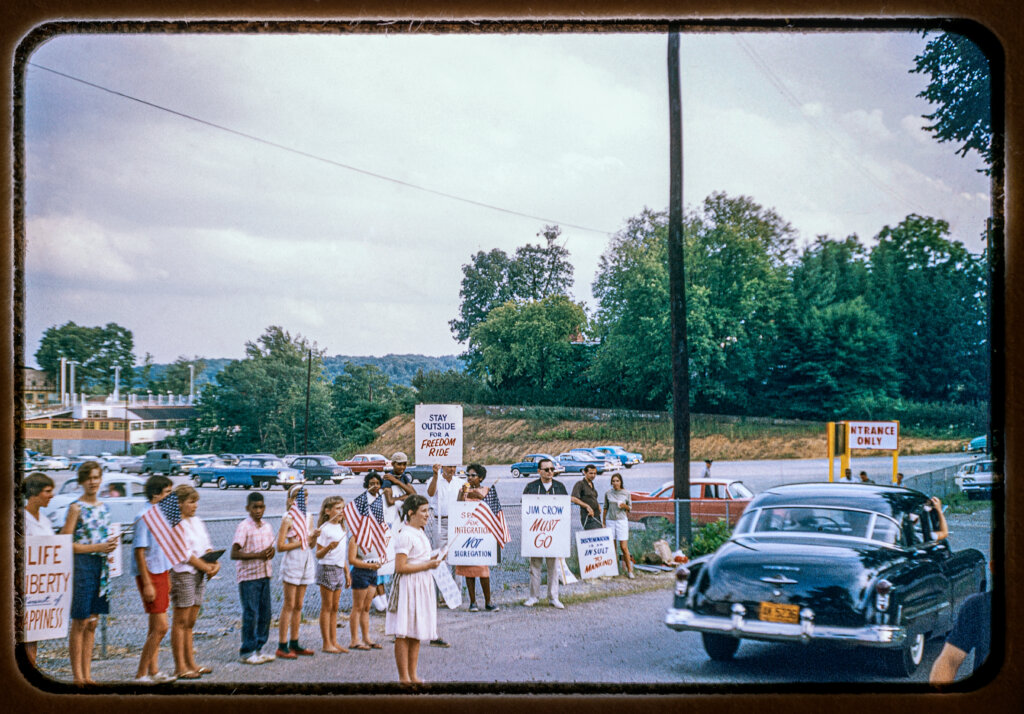A protester participates in a sit-in at the segregated Glen Echo Amusement Park. Courtesy of Kim Dixon
At first glance, the documentary Ain’t No Back to a Merry-Go-Round seems like a familiar story of Black-Jewish allyship during protests of the civil rights era. But the narrative becomes more complicated when it’s revealed that the coalition in the film was actually protesting other Jews.
The documentary focuses on the 1960 alliance between Howard University students and Jewish community members fighting for the integration of the Glen Echo Amusement Park in suburban Maryland. Director Ilana Trachtman, best known for Praying With Lior, a documentary about a boy with Down syndrome preparing for his bar mitzvah, mixes archival footage with present day interviews to take viewers deeper into lives of the activists and details of the protest. But the film is also a microcosm of the complicated relationship Jews have always had with race in America.
The Glen Echo Amusement Park was founded as a “whites only” establishment in 1911. When Jewish brothers Abram and Samuel Baker purchased the park in 1955, they maintained the racist policy. In the summer of 1960, the Nonviolent Action Group (NAG), formed by Howard University students, picketed the institution and were immediately joined by white — and primarily Jewish — residents of the nearby neighborhood of Bannockburn.

Bannockburn was formed by Jewish and Catholic families who were prohibited from buying homes elsewhere in Glen Echo. The residents — who included Holocaust survivors — considered Glen Echo’s policy to be reminiscent of the type of discrimination they themselves had faced. Towards the end of the film, Black NAG member Hank Thomas says that Jews were the most important allies in the civil rights movement.
And yet, at Glen Echo, Jews also acted as enforcers of a policy steeped in the same ideologies of racial purity that had led to the extermination of over six million Jews in Europe not even 30 years prior. According to the film, as the protests attracted more media attention, the Baker brothers defended themselves against accusations of racism, stating the policy was not representative of their own views on race, but that integrating would be bad for business.
Ironically, the most vocal support for the Baker brothers’ policy came from the American Nazi Party. Founder George Lincoln Rockwell led counter-demonstrations against the NAG and Bannockburn marchers. The film shows men in brown shirts and swastika arm bands brandishing signs with a variety of slurs but also accusations of conspiracy: “Race mixing is funded and led by Jews,” one sign reads. Whether or not Rockwell knew he was marching to protect the white purity of a Jewish-owned business is unclear.
This complicated story demonstrates that Jewish people are not and have never been a political monolith and that occasionally Jews have played a role in the systemic racism that has plagued America since its founding. This became especially true after Jews were increasingly accepted in mainstream society as part of the white class in the mid-20th century and were afforded places of power that other races were not.
And yet Jewish whiteness often still feels like a myth. In the movie, Rockwell rails that “half the so-called white people leading these [Civil Rights] movements are Jews.” Today’s white supremacists have made it clear that Jews are not included in their definition of a white society. The story of opposing Jewish sides at Glen Echo can be understood as a stark reminder of Jews’ inability to fit into the overly-simplistic Black-white treatment race is often given in America.
By August 1960, celebrities and politicians began publicly supporting the protesters. Multiple public officials, including Congressman Adam Clayton Powell, joined the picket line. Sammy Davis Jr., who converted to Judaism that very same year, agreed to do a show to raise legal defense funds for arrested protesters.
The park closed for the season at the end of the summer, and the picketers left with plans to come back in full force when it reopened. But on March 14, 1961, the Baker brothers announced that for the first time in the park’s history, they would allow all races into the park.
Glen Echo Park closed in 1968 due to low attendance — the film does not address whether or not this was a direct result of the integration. In 1971, it was turned into a national park and continues today to serve the community as an arts and culture center.
Ain’t No Back to a Merry-Go-Round will be showing at the New York Jewish Film Festival on Wednesday, January 29th at 1:00 PM and 7:00 PM.

I hope you appreciated this article. Before you go, I’d like to ask you to please support the Forward’s award-winning, nonprofit journalism so that we can be prepared for whatever news 2025 brings.
At a time when other newsrooms are closing or cutting back, the Forward has removed its paywall and invested additional resources to report on the ground from Israel and around the U.S. on the impact of the war, rising antisemitism and polarized discourse.
Readers like you make it all possible. Support our work by becoming a Forward Member and connect with our journalism and your community.
— Rachel Fishman Feddersen, Publisher and CEO
